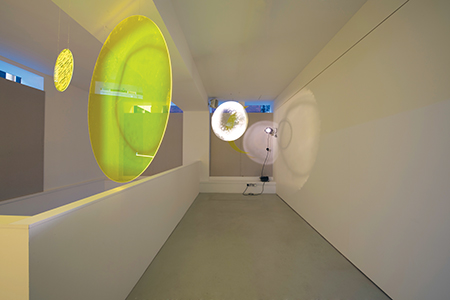Paul Kneale
Evelyn Yard, London, UK
Evelyn Yard, London, UK

Of all the questions raised by Paul Kneale’s recent exhibition at Evelyn Yard, the one with the most elusive answer was, ‘Why do the works on show look so shabby?’ Here was a group of sculptures made out of familiar materials – including Perspex, neon, paper and aluminium – exploring the links between optics and perception, and investigating the naturalization of digitally constructed images. But the works had been realized with a gestural looseness and imperfect finish that verged on expediency. 3D lens flare (2015), installed on the gallery’s mezzanine, consisted of four pieces of clear and yellow Perspex hung in a row that receded into the corner. Closest to the entrance to the space, a small circle was followed by a large one, a medium-sized one and finally a crescent, suspended just in front of a lamp like those used on film sets. The medium-sized circle was ringed with a single wobbly line of spray paint and the small one had been covered all over with scribbles, like a child’s depiction of curly hair. The bright light showed up scratches, fingerprints and scattered dust on the shiny plastic, revealing the pristine, laser-cut material to be a surface marked by the vicissitudes of life in an artist’s studio. The projection cast an image on the wall behind that resembled an illustration of a cell – a nucleus floating in watery yellowish plasma. Face on, the work was a sculptural translation of lens flare, a visual effect produced by stray light reflecting within a camera lens, which can also be artificially rendered in digital post-production.
Downstairs, Quantum £1 shop I (2015) was a gathering of low tables handmade from aluminium drywall frames, some of the legs of which were misaligned in an example of the kind of slight but eye-catching imperfection that characterizes Kneale’s work. The mirrored Perspex tabletops buckled with bumps and blemishes where the artist had melted or burned their previously immaculate surfaces. Cheap digital clocks were strung up on a structure simulating a dropped ceiling frame, hovering like B-movie flying saucers with their analogue faces mirrored in the tables’ surfaces. The clocks’ second hands had been replaced with unevenly flashing LEDs, each marking time at its own rate. The group of tables rested on a layer of grubby Corex floor covering, evoking an unspecified place undergoing renovation at an uncertain time.
Kneale calls his aesthetic the ‘new abject’, a neat rhetorical tag that seeks to convey the existential and material unrest that accompanies both free digital products, such as Google software, and the expensive hardware required to run such programmes. This is not the extroverted abject of condiments splattered on genitals but, rather, the subtle corruption of materials and minds associated with user interfaces of all kinds: the hairline scratch debasing the gloss of an iPhone screen: the woolly solutions offered by life-enhancing apps or the made-in-China plastic poverty of so many objects that surround us. The look involves neutral colours, white or clear plastic, materials unyielding to the touch and harbouring a poisonous half-life. This shabby ‘new abject’ can be read as part of a current trend away from a Koonsian aesthetic of immaculate conceptions – a new chapter in an ongoing story whose narrative swings between the mythos of technological purity and the realism of the handmade.
As a postscript to the show, Kneale has enlisted the help of researchers developing Google’s new natural language-processing system. They have agreed to analyze his installation shots using a new technology intended to generate sophisticated text descriptions of pictures by identifying not only content – a service that already exists – but also a sense of context, action and time. These descriptions will offer what Kneale calls a more ‘human nuanced’ reading of images. The action of converting image into text recalls the artist’s translation of light into sculpture: neither process can escape imperfection or telling blunders. How Google’s system will cope with photographs depicting Kneale’s art works, which render photographic effects and abstract concepts such as time and place in three dimensions, remains to be seen.
























